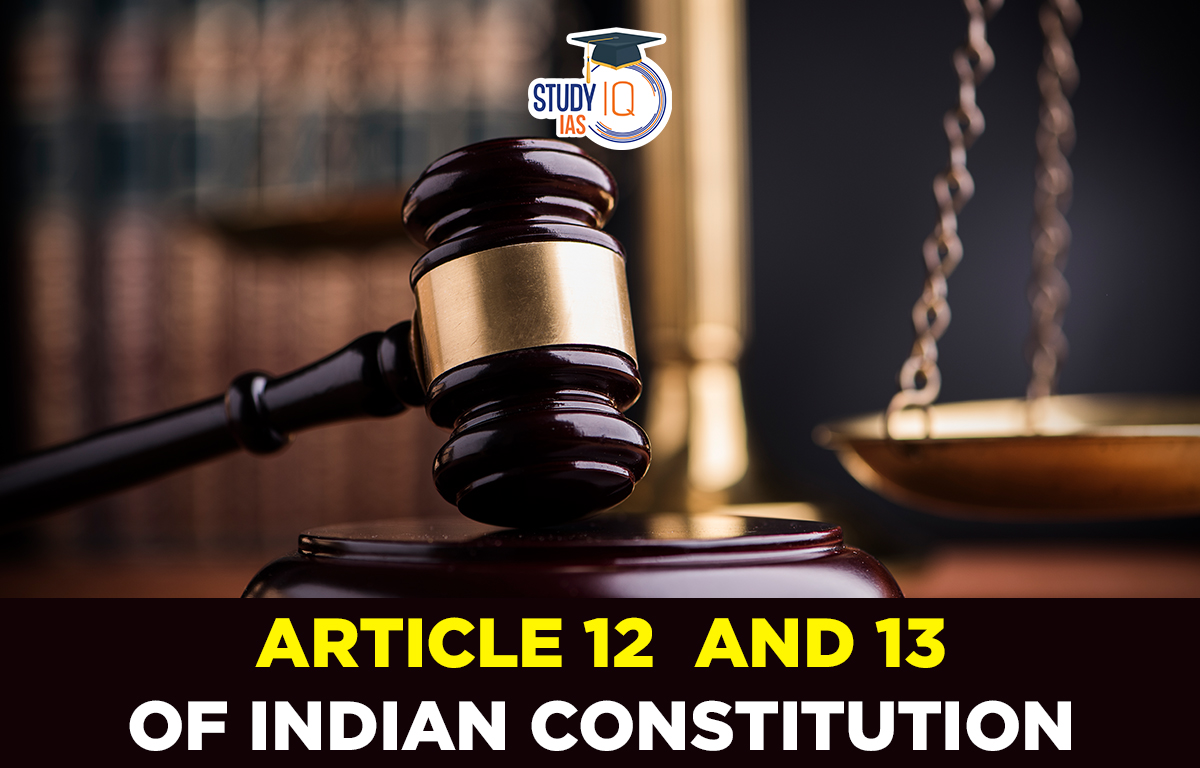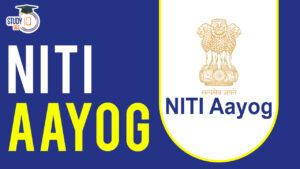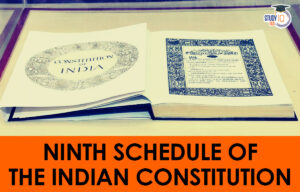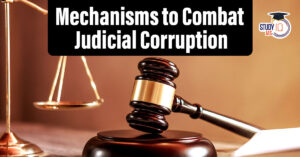Table of Contents
Articles 12 and 13
Articles 12 and 13 are the Fundamental Rights under Part III of the Constitution of India. A State is defined by the Indian Constitution’s Article 12 while Article 13 deals with the laws that are inconsistent with or in derogation from Fundamental Rights.
Article 12 of Indian Constitution
Part III of the Indian Constitution is about Fundamental Rights, which protect citizens’ rights related to speech, religion, education, culture, and more. Because these rights are important, the term “State” is defined broadly in Article 12. This means it includes all agencies and actions that can be challenged in the Supreme Court if they violate any of these fundamental rights.
Read More: Right to Equality
Definition of State under Article 12
In this Part, unless the context otherwise requires, “the State’’ includes the Government and Parliament of India and the Government and the Legislature of each of the States and all local or other authorities within the territory of India or under the control of the Government of India.
Article 12 defines ‘State’ as:
-
Union Government:
- Indian Government
- Indian Parliament (Lok Sabha, Rajya Sabha)
2. State Governments:
- State Legislatures (Legislative Assembly, Legislative Council)
- Local authorities (Municipalities and Panchayats)
3. Statutory Authorities:
- National Human Rights Commission
- National Commission for Women
- National Law Commission
- National Green Tribunal
- Armed Forces Tribunal
4. Non-Statutory Authorities:
- Central Bureau of Investigation
- Central Vigilance Commission
- Lokpal and Lokayuktas
Note: This definition is used for applying the rules in Part III of the Constitution. Even if a party isn’t listed as a ‘State’ under Article 12, it can still face legal action if it has a public duty or its actions are supported by the State, according to Article 226.
Read More: Preamble of Indian Constitution
Article 12 Importance
Ordinary laws are sufficient to safeguard against individual rights infringement. However, because the state has been given illimitable power and authority, citizens must be protected by the constitution from the actions of the state. A precise definition of state must be provided in order to provide this protection.
Though Article 12 gives a clear definition of the state, controversies arise due to the 4th category i.e. ‘’other authorities’’. The inclusion of an organisation in the definition of state would make it amenable to the writ jurisdiction of the Supreme Court under Art. 32.
Read about: Important Articles of Indian Constitution
Article 12 Other Authorities Meaning
The term ‘Other Authorities’ in Article 12 refers to any authorities in India that are controlled by the government through its laws and amendments.
- In the case of Ujjain Bai v. State of Uttar Pradesh, the Supreme Court explained that “other authorities” cannot be considered the same as the Government, Legislature, or Local authorities.
- In R.D. Shetty v. Airport Authority of India, Justice P.N. Bhagwati listed five points to determine if a body qualifies as ‘State’ under Article 12:
The body’s entire capital is owned by the Government of India.
- It has a governmental function.
- The government has complete control over it.
- It possesses authority or command.
- It provides a public service.
Read More: Salient Features of Constitution of India
Article 12 include Judiciary or Not?
Article 12 of the Constitution does not define “judiciary” in any particular way. Thus, to answer whether Judiciary comes under the definition of the state we have to look at the functions of the Judiciary. The functions of the Judiciary can be divided into judicial and non-judicial functions.
Functions Performed by the Judiciary
The functions of the Judiciary can be divided into judicial and non-judicial functions.
- Non – Judicial Functions: When the courts perform their non-judicial functions, they fall within the definition of the ‘State’. Thus, an administrative decision or a rule made by the judiciary can be challenged as being violative of the fundamental right
- Judicial Function: When the courts perform the judicial functions, they will not fall within the scope of the ‘State’. Thus, the judicial decision of a court cannot be challenged as being violative of fundamental rights.
Read More: Directive Principles of State Policy
Article 13 of Indian Constitution
Article 13 of the Indian constitution, addresses all those laws which are inconsistent with or in derogation of fundamental rights. As per Article 13, all such laws in force in the territory of India immediately before the commencement of this Constitution, to the extent as they are inconsistent with the provisions of Part III of the Indian Constitution, shall be void.
Hence, Article 13 forms the basis of the doctrine of judicial review and aids the court and citizens to check the misuse of powers by the legislature and executive. Article 32 and Article 226 confer the power to the Supreme Court and the High Courts through which they can declare a law unconstitutional and invalid on the ground of contravention of any of the Fundamental Rights. This places the judiciary as the guardian, protector, and interpreter of fundamental rights. Article 13 constitutes law as:
- Permanent laws enacted by Parliament or state legislatures.
- Temporary laws such as ordinances by the president or the governors of the state.
- Statutory instruments in the nature of delegated legislation i.e. executive Legislation as regulation or notification, order, bye-law, rule.
- Non-legislative sources of law i.e. custom or usage having the force of law.
- Even a constitutional amendment act can be challenged.
Article 13 Provisions
| Article 13 |
|
Judicial Pronouncement of Article 13
Article 13 of the Indian Constitution has led to important court cases that clarify its meaning and use. Here are some key rulings:
- Keshavan Madhavan Menon vs. State of Bombay (1951): The Supreme Court stated that fundamental rights do not apply retroactively. Laws before the Constitution can be invalid if they conflict with these rights.
- Shankari Prasad Singh Deo vs. Union of India (1951): This case challenged the first Constitutional amendment for violating fundamental rights. The Court ruled that “law” in Article 13 does not include constitutional amendments, only regular laws.
- State of Bombay vs. Narasu Appa Mali (1952): The Court decided that personal laws are not considered “laws in force” under Article 13, meaning they aren’t subject to the same rules as statutory laws.
- I.C. Golaknath vs. State of Punjab (1967): The Supreme Court ruled that constitutional amendments could be challenged under Article 13. This meant Parliament could not change Part III of the Constitution if it violated fundamental rights.
- Kesavananda Bharati vs. State of Kerala (1973): This case reversed the Golaknath ruling, allowing Parliament to amend the Constitution, including fundamental rights, as long as the basic structure of the Constitution is preserved.
- Minerva Mills vs. Union of India (1980): The Court reaffirmed that fundamental rights can be amended, but those amendments must respect the Constitution’s basic structure.
- Indian Young Lawyers Association vs. State of Kerala (2018): The Supreme Court ruled that customs, like the ban on women entering the Sabarimala temple, are included in the definition of “law” under Article 13 and can be reviewed by the courts.
These cases highlight the ongoing evolution of fundamental rights and their protection in India.
Constitutional Amendment under Article 13
The Constitution (Twenty-Fourth Amendment) Act, 1971, was passed on November 15, 1971. It overturned the Supreme Court’s ruling in the I.C. Golak Nath case, which limited Parliament’s power to change Fundamental Rights. This amendment updated Articles 368 and 13, giving Parliament more freedom to modify Fundamental Rights. It added a new clause to Article 13, stating that the article does not apply to amendments made under Article 368.


 NITI Aayog Report on India’s Hand and ...
NITI Aayog Report on India’s Hand and ...
 9th Schedule of Indian Constitution: His...
9th Schedule of Indian Constitution: His...
 Mechanisms to Combat Judicial Corruption...
Mechanisms to Combat Judicial Corruption...





















